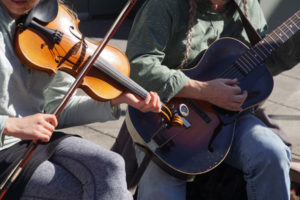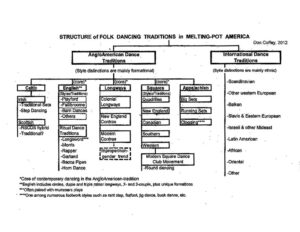Structure of American Folk dancing
Structure of Folk Dancing Traditions in Melting-Pot America
By Don Coffey
After folk dancing became integral to my life starting in 1971, I often wondered how the dances I encountered, with such seeming randomness, fit into some larger “folk dance” sort of structure.
I’ve always liked understanding the big picture (or trying to) of whatever enterprise I got involved in, but I must say comprehension of folk dancing’s context came slowly to me. What was a meaningful way to categorize the dances I was encountering? By historical period (since these clearly were antique dances)? By formation (one of the first things new dancers notice)? By something else unperceived?
Years rolled by and the question persisted. Sometimes I’d ask an oldtimer, but their answers never quite seemed to cover the ballpark. Sometimes I’d look in books, where modern dance taxonomies galore told me useless things like: Ballet; ballroom; cha-cha; bunny hop; folk… The question became a permanent fixture way on the back-most shelf of my mind, labeled “confused.”
That was long ago. I’m old now, and think I have figured it out pretty much all by myself. It certainly didn’t come all at once, but oh so slowly it came. And so I decided lately to sit down and dump my version onto the accompanying chart, then see if anyone at all agrees with me. I know the chart is rudimentary and every block could be refined in a dozen directions, but I wanted to get the basic idea on one page.
I’m sure different versions exist in other heads, because I’ve noticed not a little disagreement over the years on seemingly basic, simple things – such as a definition of the term “folk dancing.” Some will no doubt quibble with what I’ve called “core” – even though I’ve used (and seen that others use) the core concept for programming numerous dance camps over the years. What would be more interesting is to discover the areas of most agreement. Maybe a bit of useful dialogue might even be stimulated by putting my chart out there for others to ponder.
It seems to me that this subject is worth thinking about, especially if you really like folk dancing. Or even more especially if you’re a leader who plans and produces dance events, or a caller who travels a lot. Why bother? Well, in the arena of what I’d call “significant” are observations such as these:
- Modern contra dancing has become a mass “movement” with the energy of a freight train, but most of the young people who so love contras – and contras only – have no idea it is but one component of a larger, very wonderful, tradition. This horse-blinder focus rather reminds me of…
- …an earlier movement, western square dance “clubs,” which roared to prominence from the 1950s through 80s and attracted thousands. It has declined drastically as club populations aged, young dancers were not attracted “in,” and clubby “dance lessons” became ever more costly and complex.
- Similar to the way the western club movement strove to standardize individual square dance figures so that every square dancer nationwide would dance them “uniformly, the same way” (as if in lock step, one might say), I perceive comparable urges at work in the contras-only movement. One night some out-of-town visitors to our Friday night dance, long accustomed to automatically lining up in improper formation, had repeated difficulty adapting to our simple, ordinary, Ralph Page contras.
- At least two of my caller friends, both very popular and widely traveled, have received open criticism when they tried to introduce a really-fun square or English dance to a contra dance crowd. Makes me wonder how a rowdy foot-stompin’ Appalachian running set would have been received.
- And then there’s the two whole separate worlds of “international” folk dancing and “AngloAmerican” folk dancing … and why don’t their two large populations even know each other? It’s as if they were on different planets. Let’s say it again: All these dances are fun! They are living history that we, who love them, are responsible to care for, to preserve by dancing them, and to pass on to the next generation.
To repeat myself, it seems to me that a bit of polylogue on my proposed Structure-Of-Folk-Dance chart – not to mention these little issues – might be healthy, even productive, for our folk dance community at large. Next time you pass through Frankfort, Kentucky, please feel welcome to drop in and join our Friday night dance. Our dance nights typically include a sampling of just about everything on the chart. We like ‘em all – and live music for all the dances is provided by our Capital City Country Dance Orchestra. What fun!

